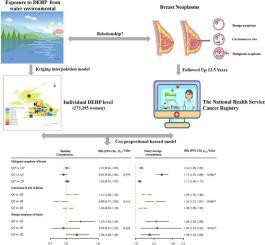当前位置:
X-MOL 学术
›
Sci. Total Environ.
›
论文详情
Our official English website, www.x-mol.net, welcomes your feedback! (Note: you will need to create a separate account there.)
Exposure to di-2-ethylhexyl phthalate and breast neoplasm incidence: A cohort study
Science of the Total Environment ( IF 9.8 ) Pub Date : 2024-03-19 , DOI: 10.1016/j.scitotenv.2024.171819 Lijuan Tang , Yimeng Wang , Wenting Yan , Zhe Zhang , Siwen Luo , Qiaorui Wen , Shengfeng Wang , Niya Zhou , Qing Chen , Yan Xu
Science of the Total Environment ( IF 9.8 ) Pub Date : 2024-03-19 , DOI: 10.1016/j.scitotenv.2024.171819 Lijuan Tang , Yimeng Wang , Wenting Yan , Zhe Zhang , Siwen Luo , Qiaorui Wen , Shengfeng Wang , Niya Zhou , Qing Chen , Yan Xu

|
Phthalates are ubiquitous environmental endocrine disruptors. As the predominant phthalate, di-2-ethylhexyl phthalate (DEHP) has been considered possibly carcinogenic to humans but large-scale longitudinal evidence is needed to further clarify its carcinogenicity. To examine the association between DEHP exposure and incidence of breast malignant neoplasm, carcinoma and benign neoplasm. A total of 273,295 women from UK Biobank cohort were followed up for a median of 13.5 years. Disease information was collected from National Health Service Cancer Registry and National Death Index. Baseline and yearly-average level of DEHP exposure were estimated for each individual by linking chemical monitoring record of European Environment Agency with home address of the participants by Kriging interpolation model. Cox proportional hazard model was employed to estimate the association between DEHP exposure and breast neoplasms. The median (IQR) of baseline and yearly-average DEHP concentration were 8000.25 (interquartile range: 6657.85–11,948.83) and 8000.25 (interquartile range: 1819.93–11,359.55) μg/L. The highest quartile of baseline DEHP was associated with 1.11 fold risk of carcinoma (95 % CI, 1.00, 1.23, < 0.001) and 1.27 fold risk of benign neoplasm (95 % CI, 1.05, 1.54, < 0.001). As for yearly-average exposure, each quartile of DEHP was positively associated with higher risk of malignant neoplasm (HR, 1.05; 95 % CI, 1.03, 1.07, < 0.001), carcinoma (HR, 1.08; 95 % CI, 1.04, 1.11, p < 0.001) and benign neoplasm (HR, 1.13; 95 % CI, 1.07, 1.20, p < 0.001). Stratification analysis showed no significant modification effects on the DEHP-neoplasm relationship by menopausal status or ethnicity but a suggestive higher risk in younger women and those who underwent oral contraceptive pill therapy. In sensitivity analysis, the associations remained when excluding the cases diagnosed within 2 years post baseline. Real-world level of DEHP exposure was associated with higher risk of breast neoplasms. Because of the health risks associated with DEHP, its release to the environment should be managed.
更新日期:2024-03-19



























 京公网安备 11010802027423号
京公网安备 11010802027423号